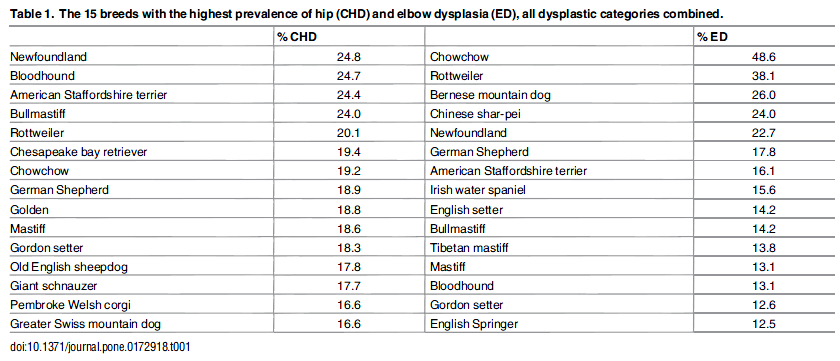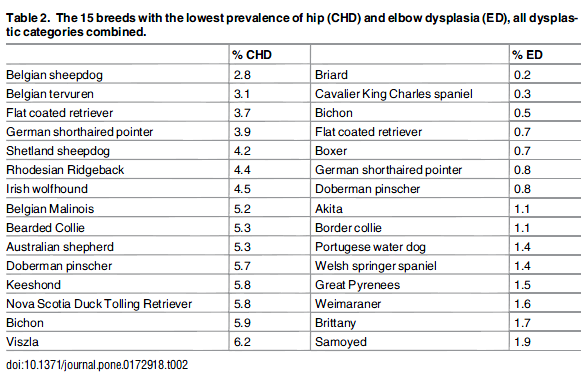Elsewhere on DogWellNet.com we have other articles describing international programs for hip dysplasia and evidence that these programs are having a beneficial effect. Katariina Mäki from the Finnish Kennel Club has posted information about improvelments in that country in Finnish dog breed populations improving their health - hip dysplasia and Frequency of canine hip and elbow dysplasia decreasing in Finland. Links to international screening protocols are listed here.
A research study entitled Long-term genetic selection reduced prevalence of hip and elbow dysplasia in 60 dog breeds was published on Feb 24, 2017 using data from the Orthopedic Foundation for Animals. This is a welcome addition to the literature. As the authors indicate below, the OFA data represent a non-compulsory listing, as all information is provided voluntarily by dog owners. Some studies from, e.g. Finland, represent a complete population of registered dogs. There are benefits and challenges in any approach to data collection and analysis. One theme at the 3rd International Dog Health Workshop in Paris in April 2017 will focus on the potential and challenges in using various data sources to inform health strategies for dogs.
Links to research paper ...
External
- http://journals.plos.org/plosone/article?id=10.1371%2Fjournal.pone.0172918
- http://journals.plos.org/plosone/article/file?id=10.1371/journal.pone.0172918&type=printable (PDF)
A. M. Oberbauer1*, G. G. Keller2, T. R. Famula1
1 Department of Animal Science, University of California, Davis, Davis, CA United States of America,
2 Orthopedic Foundation for Animals, Columbia, MO United States of America
"Abstract
Canine hip dysplasia (CHD) and elbow dysplasia (ED) impact the health and welfare of all dogs". ... "The present study evaluated the efficacy of employing phenotypic selection on breed improvement of hips and elbows using the Orthopedic Foundation for Animals complete database spanning the 1970–2015 time period. Sixty breeds having more than 1000 unique hip evaluations and 500 elbow evaluations (1,056,852 and 275,129 hip and elbow records, respectively) were interrogated to derive phenotypic improvement, sex and age at time of assessment effects, correlation between the two joints, heritability estimates, estimated breeding values (EBV), and effectiveness of maternal/paternal selection. The data demonstrated that there has been overall improvement in hip and elbow conformation with a reduction in EBV for disease liability, although the breeds differed in the magnitude of the response to selection. Heritabilities also differed substantially across the breeds as did the correlation of the joints; in the absence of a universal association of these differences with breed size, popularity, or participation in screening, it appears that the breeds themselves vary in genetic control. There was subtle, though again breed specific, impact of sex and older ages on CHD and ED. There was greater paternal impact on a reduction of CHD. In the absence of direct genetic tests for either of these two diseases, phenotypic selection has proven to be effective. Furthermore, the data underscore that selection schemes must be breed specific and that it is likely the genetic profiles will be unique across the breeds for these two conditions. Despite the advances achieved with phenotypic selection, incorporation of EBVs into selection schemes should accelerate advances in hip and elbow improvement.
"The objectives of the present study were to characterize the influence of non-compulsory selection on phenotypic radiographic assessment of hip and elbow conformation over time. Dog breeds that were most highly participatory in a voluntary United States radiographic screening process for hips and elbows were evaluated for improvement, whether maternal or paternal selection was more responsible for any observed progress, whether some breeds prove more amenable to selection than others, and whether selection against one orthopedic disorder yielded concomitant improvement in the other."


OUTTAKES...


Discussion
"Minimizing the incidence of debilitating orthopedic disorders is paramount, yet past studies that have evaluated CHD and ED heritability report highly variable estimates and nominal response to selection. Contributing factors to disparate heritability estimates include sample size, breed composition, and relatedness of the population studied. The time frame under study, if the evaluation scheme is voluntary or mandatory, and if all evaluations are available for analyses also influence the accuracy of the estimate and assessment of joint improvement. In the absence of DNA-based genetic testing, utilization of estimated breeding values based upon phenotypic radiographic assessment related to CHD and ED has been promoted. Therefore, it is important to best characterize the potential improvement that can be achieved based upon phenotypic selection. The present study was undertaken to comprehensively assess the impact of phenotypic selection on hips and elbows over several decades in multiple dog breeds."
 Donate
Donate
Recommended Comments
There are no comments to display.
Join the conversation
You can post now and register later. If you have an account, sign in now to post with your account.
Note: Your post will require moderator approval before it will be visible.